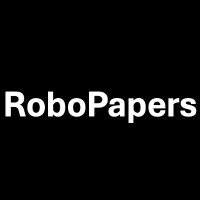
RoboPapers
@robopapers
@chris_j_paxton & @micoolcho geeking out weekly with authors of robotics AI papers. On YouTube / X / Spotify
ID: 1888753998674665472
https://www.youtube.com/@RoboPapers 10-02-2025 00:57:10
23 Tweet
851 Followers
2 Following

Full episode dropping soon! Geeking out with Haoyu Xiong on Vision in Action - Learning Active Perception from Human Demonstrations vision-in-action.github.io Co-hosted by Michael Cho - Rbt/Acc Chris Paxton


Full episode dropping soon! Geeking out with Zixuan Chen GMT: General Motion Tracking for Humanoid Whole-Body Control gmt-humanoid.github.io Co-hosted by Michael Cho - Rbt/Acc Chris Paxton

Full episode dropping soon! Geeking out with Zixuan Chen GMT: General Motion Tracking for Humanoid Whole-Body Control gmt-humanoid.github.io Co-hosted by Michael Cho - Rbt/Acc Chris Paxton


Full episode dropping soon! Geeking out with Gokul Swamy Arnav Jain Vibhakar Mohta on 𝚂𝙰𝙸𝙻𝙾𝚁: Robust Imitation via Learning to Search gokul.dev/sailor/ Co-hosted by Michael Cho - Rbt/Acc Chris Paxton

Full episode dropping soon! Geeking out with Gokul Swamy Arnav Jain Vibhakar Mohta on 𝚂𝙰𝙸𝙻𝙾𝚁: Robust Imitation via Learning to Search gokul.dev/sailor/ Co-hosted by Michael Cho - Rbt/Acc Chris Paxton

Full episode dropping soon! Geeking out with Pranav Atreya Karl Pertsch on RoboArena: Distributed Real-World Evaluation of Generalist Robot Policies robo-arena.github.io Co-hosted by Michael Cho - Rbt/Acc Chris Paxton

Full episode dropping soon! Geeking out with Pranav Atreya Karl Pertsch on RoboArena: Distributed Real-World Evaluation of Generalist Robot Policies robo-arena.github.io Co-hosted by Michael Cho - Rbt/Acc Chris Paxton


Full episode dropping soon! Geeking out with Paul Zhou Qiyang Li on Reinforcement Learning with Action Chunking colinqiyangli.github.io/qc/ Co-hosted by Michael Cho - Rbt/Acc Chris Paxton

Full episode dropping soon! Geeking out with Paul Zhou Qiyang Li on Reinforcement Learning with Action Chunking colinqiyangli.github.io/qc/ Co-hosted by Michael Cho - Rbt/Acc Chris Paxton


Feel episode dropping soon! Geeking out with Yutong Bai on Whole-Body Conditioned Egocentric Video Prediction dannytran123.github.io/PEVA/ Co-hosted by Michael Cho - Rbt/Acc Chris Paxton

Feel episode dropping soon! Geeking out with Yutong Bai on Whole-Body Conditioned Egocentric Video Prediction dannytran123.github.io/PEVA/ Co-hosted by Michael Cho - Rbt/Acc Chris Paxton

Full episode dropping soon! Geeking out with Jeremy Collins on AMPLIFY: Actionless Motion Priors for Robot Learning from Videos amplify-robotics.github.io Co-hosted by Michael Cho - Rbt/Acc Chris Paxton


Full episode dropping soon! Geeking out with Jeremy Collins on AMPLIFY: Actionless Motion Priors for Robot Learning from Videos amplify-robotics.github.io Co-hosted by Michael Cho - Rbt/Acc Chris Paxton